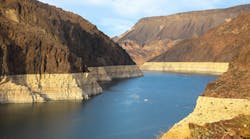About the author: Ben Bogner is corrosion and infrastructure market specialist for AOC LLC. Bogner can be reached at 630.665.2675 or by e-mail at [email protected].
Related search terms from www.waterinfolink.com: sewer outfall, composite panel
When an almost 80-year-old semi-elliptical sewer pipeline in Los Angeles showed signs of imminent failure, the emergency solution was a new liner of fiber-reinforced polymer composite panels manufactured by Channeline Intl. Ltd. The resin formulation for Channeline’s composite production incorporated Vipel corrosion-resistant technology from AOC.
The new composite liner was part of a major emergency repair of the city of Los Angeles’ North Outfall Sewer (NOS). A brief history of the NOS helps explain the nature of the problem. It was built between 1923 and 1929 using cast-in-place concrete to form a semi-elliptical pipeline that connected the San Fernando Valley to the Los Angeles sewer system. Clay tiles were applied to the pipe interior to form a protection layer.
In 1939, the Army Corps of Engineers lowered the bed of the Los Angeles River to ease the threat of flooding during southern California’s November to January rainy season. In the process, a river siphon was created with round reinforced concrete pipe. When part of the concrete siphon was undermined and collapsed in the summer of 2007, the adjacent sewer pipe was exposed, creating the potential for sewer discharge into the river come the rainy season.
One Emergency Response Team Leads to Another
The city of Los Angeles commissioned emergency response contractor Vido Artukovich and Sons, El Monte, Calif., to repair the damaged siphon. Artukovich and Sons staff quickly set up a sewer flow bypass and rehabilitated the precarious siphon by Oct. 15, before the start of the
rainy season.
During the repair, a video inspection of the NOS system revealed that the 290-ft-long upstream section of the old noncircular concrete sewer pipe had deteriorated. The reach included several curved alignments of about 100 ft. With most of the clay tile protective layer missing, the potential for failure was imminent. A solution was needed—and fast.
As a result, Channeline was contracted in late October to assist in the design and installation of composite liner panels on an emergency basis. Channeline manufactured the panels using a design solution based on the work of WRc, a U.K.-headquartered global engineering consultancy specializing in water and wastewater systems.
Panels Installation
The panel cross section was semi-elliptical in shape, with a width of 47 in. and a height of 40 in. The panels were manufactured in a resin matrix that used Vipel technology from AOC to achieve required structural properties and long-term resistance to corrosive attack.
To make the panels, Channeline used a hand lay-up construction in which a polymer resin core was sandwiched between layers of Vipel resin-impregnated glass fabrics. The reinforcement was a combination of unidirectional fiberglass mat and chopped strand mat. Two different Vipel technologies were involved; the inner layers were made with a vinyl ester to give a high degree of chemical resistance in the sewerage environment, and the core laminate and outer layers were made with an unsaturated polyester.
“The AOC resins met our needs to have a fairly long pot life and be able to lay up the thick laminates and core without slump or sag,” said Robert Walters, chairman of APS Dubai, of which Channeline is a wholly owned subsidiary. “The service was generally of an exceptionally high standard. We particularly appreciated the fact that AOC Export Manager Steve Olle saw to it that we got what we needed when we needed it.”
The composite panel sections were shipped by mid-February 2008 from the Channeline manufacturing facility in Dubai. The panels arrived at the Los Angeles job site in mid-April and were installed in a matter of weeks.
The panels were site-bonded together using a proprietary epoxy putty bonding agent called Channeline 3000, which provides high strength and a long-term bond.
The bypass pumps were shut off in May to allow the full flow to pass through the newly rehabilitated system, and the NOS was prepared for southern California’s next major storm event.
Download: Here

